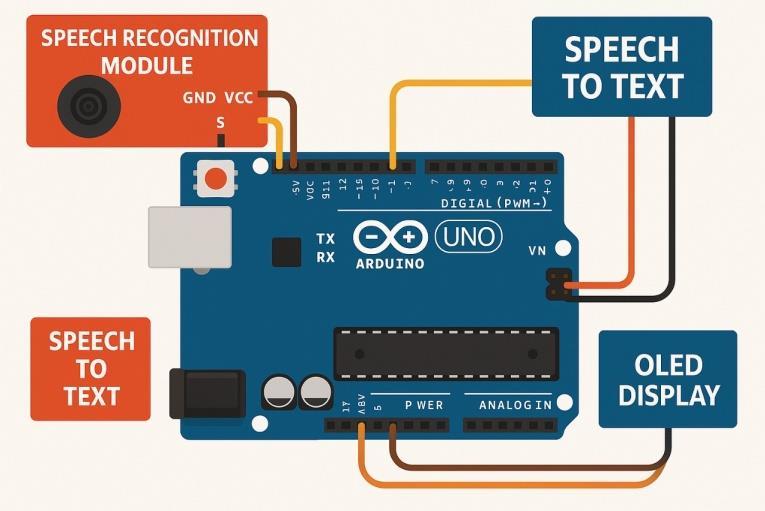
International Research Journal of Engineering and Technology (IRJET) e-ISSN: 2395-0056
Volume: 12 Issue: 05 | May 2025 www.irjet.net p-ISSN: 2395-0072


International Research Journal of Engineering and Technology (IRJET) e-ISSN: 2395-0056
Volume: 12 Issue: 05 | May 2025 www.irjet.net p-ISSN: 2395-0072
Shashwat Chaturvedi, Bhumi Pandey, Arnav Singh, Abhishek Singh
Sunbeam School Varuna, Central Jail Road, Varuna, Varanasi ***
Abstract - Children with physical or mental challenges often face barriers in being inclusive of an environment where they have a friendly access to education, interactive learning and basic healthcare monitoring. Traditional classroom's teaching and learning techniques lack adaptability and accessibility which these specially abled students attentively need in order to meet their needs. This often leads to social isolation and limited academic engagementbecauseofthefearofbeingaburden.
Addressing these issues, we've developed an integrated smart chair-table system specifically designed for children upto senior secondary. This multi-functional device combines educational, entertainment and healthcare support in a single, accessible platform. The device is equipped with interactive educational games and lessons tailored to these very special needs. The key features include speech to text, text to speech and on-screen text display, whichdirectlyenablesinclusivecommunicationand learningforuserswithdiverseabilities.
With these advanced educational features, the device also incorporates a basic healthcare framework that monitors blood pressure, heart rate and oximetry levels. For enhancing the safety of the user, an integrated SOS buzzer allows users to alert caregivers in case of emergencies. The device is designed for mobility, featuring attached wheels for the ease of movement, along with a holder for a blind sticktosupportvisuallyimpairedusers.
This smart edtech solution offers a holistic approach to improving the quality of life, learning, and autonomy for differently-abledchildren,fostering inclusion, independence, and well-being in both educational and personal environments.
Keywords: Smart Chair-Table device, EdTech tool, Specially-abled students, Inclusive learning, Educational games
Nav-Adhyay is a revolutionary chair-table combo built to empower children with physical or mental challenges. More than just furniture, it’s a smart companion that blends learning, healthcare, and accessibility into one integrated system. This device consists of the following framework:
Tri-assistframework
Speech-to-text and text-to-display/speech framework Healthcareframework Screenframework
1.1 Tri-assist framework
The TriAid Framework is a unified structural design that seamlessly integrates a smart chair, adaptive table, and blind stick holder into a single, mobility-friendly unit. Engineered for children with physical or cognitive challenges, this three-in-one framework provides ergonomic support, functional accessibility, and enhanced independence all within a compact and user-centric setup.
Followingarethethreecomponentsthatbasicallymake-up thisframework:
1.1.Chair
1.2.Table
1.3.Blindstickholder

Fig1.1Tri-assetFramework
1.2 Speech-to-text and text-to-display/speech framework
This framework enables seamless communication by converting spoken words into text (Speech-to-Text) and then transforming text into visual display or audible output (Text-to-Display/Speech). Designed for children with speech or hearing impairments, it allows users to speakandseetheirwordsonscreen,orreadandheartext responses, promoting inclusive, interactive learning and expression.

International Research Journal of Engineering and Technology (IRJET) e-ISSN: 2395-0056
Volume: 12 Issue: 05 | May 2025 www.irjet.net p-ISSN: 2395-0072

1.3 Health care framework

With the Integration of real-time monitoring of essential health parameters to ensure well-being of physically or mentally challenged children. Non-invasive sensors to measurebloodpressure(BP),heartrate,andSpO2(oxygen saturation) help track vital signs regularly and in case of emergencies alert caregivers through an SOS buzzer, enablinguserstocallforimmediatehelp.
The health care framework integrates the following frameworks:
3.1.Heart-ratemonitoring
3.2.BloodPressure
3.3.SPO2
1.4 Screen framework
The Screen Framework is equipped with a smart, touchenabled interface that hosts a suite of interactive games
and educational applications tailored to children with physical or cognitive challenges. These tools are designed tomakelearningengaging,adaptive,andfun.
The educational apps cover subjects like basic math, reading, language skills, memory exercises, and life skills, usingvisualcues,audioprompts,andgamifiedlessonsthat adjust to the learner’s pace and ability. Meanwhile, inclusive games focus on cognitive development, motor skills, and problem-solving using accessible controls, simplified navigation, and rewarding feedback to keep usersmotivated.
Together,theseappscreatea stimulatingandinclusive learningenvironmentthatsupportsbothacademicgrowth and personal development, while also offering entertainmentthatissafe,purposeful,andempowering.

This meticulously designed Ed-tech assistive tech successfully brings together education, assistance in communication, and basic healthcare into a single, userfriendly platformtailoredforchildren sufferingphysically and/ormentally Itsdesignprioritizesaccessibility,safety, and mobility, empowering users with greater independenceinbothlearninganddailyactivities.

International Research Journal of Engineering and Technology (IRJET) e-ISSN: 2395-0056
Volume: 12 Issue: 05 | May 2025 www.irjet.net p-ISSN: 2395-0072
The inclusion of vital sign monitoring and an SOS feature ensures timely health support, while the integration of speech-based and visual learning tools encourages active participationandinclusivelearning.
This solution addresses real-world barriers faced by differently-abled children and offers a scalable model for inclusive development and comprehensive skill upliftment.
3. Acknowledgement
Aspecialmentiontoourteacherandmentor:
Miss Pratiksha Sahu (Teacher, engineer, mentor) Forprovidingmentorshipandresourcesforthisproject.
4. References
AratiS.N.,AmbikaB.,DivyaK,GayathriA,NidhiS, “Bluetooth Technology -Architecture, Applications, and Issues: A Literature Survey,” IRJET,vol.7issue12,Dec.2020,pp.2259-2264
LilyPad Arduino, 'LilyPad Arduino', 2015. [Online]. Available: http://lilypadarduino.org/. [Accessed:13-Sep-2015].
Louis Leo. “Working Principle of Arduino and Using it as a Tool for Study and Research.” International Journal of Control,Automation, Communication and Systems, 2014 1. 10.5121/ijcacs.2016.1203.R

